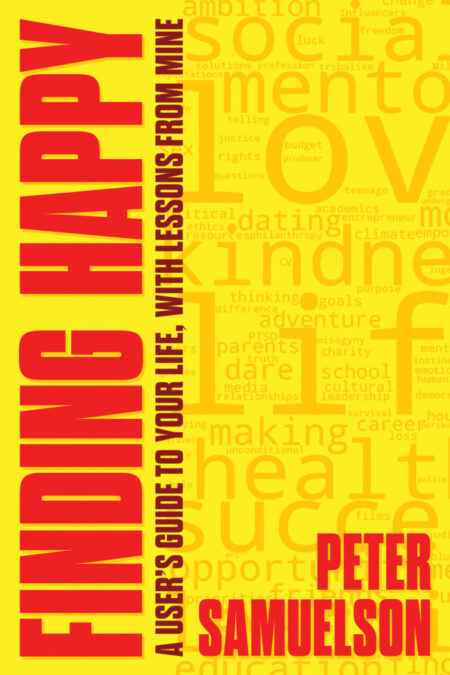I didn’t really understand the meaning of life until my mother-in-law told me to read Maimonides. I always thought the Monty Python film The Meaning of Life was the funniest thing I ever saw, at least until I produced Revenge of the Nerds and had to be loyal to my own creation. I’d thought the meaning of life was just a phrase, not really a destination. My elderly Jewish grandparents would occasionally talk favorably about the Neshuma. “He has the Neshuma,” they’d say, and I’d think, “They’re saying it as praise, so it must be good!” But I had no clue what it meant until I read Maimonides.
Maimonides was born in Spain, but lived in Alexandria, Egypt, 800 years ago. He was friends with the local Imam and priest. They had lunch together and quoted each other’s writings in their own. Maimonides said Neshuma is the top level of the human soul. Not everyone has it, and you don’t actually own your own. It’s more like a membership society of those who feel compelled to make the world a better place. Another sentence I read made the hairs stand up on the back of my neck: Maimonides said that when two people with the Neshuma met for the very first time, they would feel as though they had known each other 1000 years, and would say to each other, “Hineini,” “Here I am. What shall we do now?” And those things they did would be tikkun olam, to heal the world. I know people who inspire me that way.
I was already by then using the tool kit of a film producer to try to do some good in the world. But reading Maimonides gave me an “ah-hah moment”: Maimonides helped me grasp that philanthropy was a team sport, and that I really, really wanted to be on that team, because it was the A team of life itself. I learned about Servant Leadership, a way of managing from the middle of your team, where you lead by encouraging others through a process that brings out the best of everyone, including yourself. This delivers colossal results. This group process delivers joy to me every day. Producing two dozen films makes a fine profession, but philanthropy done right is really a privilege in my life. And I could do it well, so I thought I should. I started making changes to my life.
In 1984, my cousin introduced me to a little boy who was terminally ill. Sean lived in London, and his great wish was to see Disneyland before he passed. Although I was focused on raising my daughter and was trying to get more movies made, I realized the power of Sean’s wish. We flew him and his mom to Los Angeles. They and my cousin moved into my apartment for two weeks and we did indeed achieve his greatest wish. His mum was left with precious memories of Sean as a happy boy, and not in a hospital bed with a tube in his nose. We felt we had helped turn the wheel of life in a good way.
Maimonides chimed in when I stood at the end of a boardroom table after work one evening and suggested to a group of friends and colleagues that perhaps we could do it again, maybe half a dozen times a year. The result, all these years later, is the Starlight Children’s Foundation, with thriving programs across the United States, Canada, Australia, and the United Kingdom. All we do is make seriously ill kids happy. We have harnessed the Neshuma to unite the finest group of kindred souls I have ever met.
In 1990, Steven Spielberg and I founded Starbright World, the earliest example of a fully interactive online social network. Seriously ill teenagers in hospitals across the country had the opportunity to socialize with each other by navigating their avatar and opening video chats. All of this might seem old hat now, but 35 years ago, it was a revolution. Steven and I said “Hineini” to each other, and another A Team of good deeds was able to create happiness for the kids. The Neshuma is a breeder reactor for human good: the more you do, the more you receive.
I kept going. I really felt I had no choice! In 1999, I was shocked to discover that only 6% of American kids in foster care went to college. If anybody needed a university education, it would be those without the benefit of a supportive family. I approached Gene Block, the Chancellor of UCLA and in an epic meeting, I proposed to him that we would house, educate, and encourage high-school aged foster kids for a four year period on his campus, with the goal of giving them the tools and ambition to find their own college education. Thirteen years later, FirstStar.org has hundreds of foster kids in our 12 American academies, each a partnership with a major university, and 89% of our graduates go on to college.
I invented a class in First Star to teach the Neshuma to our 10th-graders, focused on the topics of Random Acts of Kindness and Paying it Forward. In the first 90-minute class, I ask a moral question about what they would do if they encountered an older woman asleep on the sidewalk, clearly unhoused. We discuss The Golden Rule, the sense of social justice, and the Second Law of Thermodynamics, which says that all things tend toward chaos unless maintained. So, putting energy into this life we live is not optional. In the second class, I give each student $200 to give away and ask them to write about who they want to give it to. We then check a few weeks later to see what the donation’s impact was. One student in particular moved me; he wrote that he wanted to give to the Humane Society to rehome dogs, because “the last time I was down there I looked into the eyes of a puppy that had been very badly beaten, and I saw my own eyes, because I was very badly beaten too.” We learn that generosity can be part of everyone’s lives, no matter who they are.
One day in 2005, a man living on the street accosted me coming out of Nate and Al’s Deli in Beverly Hills. He thrust his fingers into my chest, palm upwards. I was flummoxed and a little scared. He was tall and disheveled. I gave him $5 and walked away very quickly. But one of the things I teach is that if you’re scared of something, so long as it won’t kill you, you should lean into it. Nike had it right, “Just do it!” I interviewed 65 homeless people I met riding around on my bicycle on weekends. I asked them two questions: “Where do you sleep?” and “How do you get money?” An old woman on Santa Monica Boulevard took me by the hand and pulled me onto a strip of land next to the San Diego Freeway. She showed me a huge cardboard box. It had been raining, so it was wet. She said to me, “This is where I sleep.” On the side of the box it said “SUB-ZERO.” I realized I owned the refrigerator, and this lady lived in its cardboard box. I collaborated with the Pasadena Art Center College of Design to create a four wheeled cart called an EDAR, because Everyone Deserves A Roof. In the daytime, you push your EDAR around and do your recycling. But at night, you park it, put on the brakes, let down the front and back, and you now have a seven-foot-long cot in an enclosure with four windows and two doors. It isn’t nearly as good as an apartment, but at $800, it is vastly better than a damp cardboard box on a rainy night.
I look back on my charitable work and realize that the deepest happiness in my life has come from making others happy. For film producers, the end product is a motion picture. For the charities I’ve founded, we create happiness for those we help and in the process find our own. I am 73 years old, but I never really understood my own Judaism until I read Maimonides. He had it exactly right: If you want to be happy, you have to do your bit to heal the world. I am pushy enough to tell you that the meaning of your life is that simple: help other people, and through those acts, you will find your own happiness. And if you pass it on, then you’ll have even more.
Peter Samuelson’s new book Finding Happy is published by Simon & Schuster/Regalo and is available as a paperback, Kindle, and as an audio book. Peter lives in Los Angeles. He and his wife Saryl have four adult children, three grandchildren, and he prays for more every day. www.samuelson.LA

